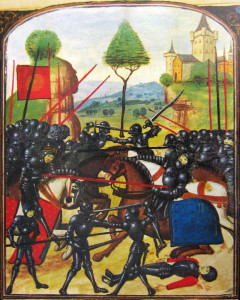
Illustration of the Battle of Barnet (14 April 1471) on the Ghent manuscript. Public domain in the US
by Lady Ayisha bint Asad
Saturday:
There being little going on in camp as yet, and it being my first Gulf, Lord Ujimori volunteered to take me on a tour of the grounds (him being so much more experienced, with this being his second Gulf).
We were waylaid by conversation in the Early Period Life camp. A number of small, permanent structures were set out in two rows, a miniature craftsman’s village. Not far from the entrance was the woodcraft building. The entire building had been constructed over the past six years, using period techniques. Many of the boards were held in place with wood pegs, rather than nails. The building had survived the Gulfnado, though it had lost a shutter in it. Two beams had been partially replaced, and for safety’s sake secured with metal brackets. Termites, I think, was said to be the reason. Up in the loft, there was lumber drying for later use. On the ladder, a knotwork creature was carved. And on one of the cornerstones, a Calatrava.
Sunday:
There were no battles scheduled yet — it was a day for classes and shopping. The morning chill had yet to fully lift, but in several layers and moving about I was finally starting to warm up. I was in one of the merchant’s tents, fingering several bolts of fabric, trying to settle on a wool to buy for a coatmaking class later that day. From a street corner, several tents down, the music of a hammered dulcimer floated by.
Sunday night:
After passing through several camps and not finding anyone I was looking for, I headed to the Purple Pavilion, center of so many stories I had heard from wars past. I was the first one there, but it was not long before I was joined by another, and soon a third. The crowd continued to grow, as I watched an orange moon creep up over the trees. There was talk of plans for the battles ahead, and tales of SCA past. And, yes, there were some modern concerns and shared interests sprinkled in amongst the conversations. Eventually, people started peeling off, and the discourse merged down to a single group.
Finally, one person left, giving a reminder to the rest of us to turn out the new battery-operated pavilion lights, and we all realized that it was midnight and we were ready for sleep. I turned out the lights, and it was just as bright outside the pavilion under the full moon. A slight cloud cover caught the light, brightening the whole sky. I made my way back to my tent at the far end of camp, the canvas tents around me glowing in the moonlight, and as I looked up the branches overhead framed the moon.
Monday:
The day that began clear had become cloudy, a flat grey. I was still in camp, preparing for the town battle to come. The armored fighters had mustered some time ago; I figured their battle had begun by that point. From the skies I heard crow calls, putting me in the moment told of in so many stories where the crows gather in anticipation of feasting on the battle’s slain.
Later Monday:
Time crept by as we waited for the appointed hour to muster. I crossed and re-crossed the space beside the Purple Pavilion, going back to my tent for tape or extra tips to stash in my pouch as I imagined potential scenarios that might occur. People came for inspections, then most disappeared again as they went to make their own final preparations. The wind picked up, and it started misting. Slowly our numbers began to grow as the hour approached. The mist turned into a drizzle, setting people bustling once more to get gear under cover. A few of the crossover fighters arrived back in camp. They rushed to switch out gear, as those of us who were waiting hastily dug through gear bags to find a few final pieces of loaner armor for them. And then the hour arrived.
We gathered, in the rain, on the road. I imagined the rust already starting to form on my blades. Someone grabbed the banner, His Majesty took his place behind it, and we were off. Master Dolan attempted to lead us in song, but we were fewer than we had hoped, and some of us did not know the words all that well, and it fell mostly to him to carry the song. I marched carefully, attempting to avoid the puddles without falling out of line, but my shoes were still soaked through before we reached Five Points.
The noise of the assembled armies was a roar which rose up to greet us as we neared the battlefield. Masses of people, gathered under the tents of many kingdoms, formed a wall along the road. We wound around the right flank of the crowd — and on the other side of the tents were our armored fighters, waiting for us. They stood in two lines, spears up, forming an arch for us to pass through, singing Steel-shod Dance. Their song welled up around us as we marched, and our voices joined theirs. In that moment, I felt we were finally accepted as part of the army. Many thanks to the armored fighters who delayed doffing their armor and partaking of the peanut butter and jelly to make that gesture.
Later still:
It was cold, and the temperature was still dropping. The near-constant wind made it worse. There had been people at the pavilion all afternoon, taking shelter from the off-and-on rain. I sat, at last moderately warm in four layers – two tunics given to me at my first full Lillies, another that had been leant to me for Gulf, and a coat that had been handed to me by a chivalrous knight who saw me cold, trapped at the Purple Pavilion by a heavy rain, under-dressed for the sudden drop in temperature.
As night fell, people gathered for a planned discussion. A foreign Count had heard of a household’s traveling game, and it had piqued his interest, so there was going to be an audience-participation demonstration of it that evening. The rules were simple: they had accumulated a book of questions, regarding the nature of the Society and life in it. Someone picks a question from the book, and debate about that question ensues. Lists of questions were passed around, and someone was called on to pick the first. It was read, and in response, opinions started flying.
Even as opinions became heated, the temperature outside continued to drop. We discussed whether service can be taught, while in the background several people quietly located the pavilion walls and put them up to help block the incessant wind. Bottles were passed around, and people passed in and out of the tent as the topic meandered. Occasionally the erstwhile moderator stepped in to call for a new question. Topics ranged from how much prowess should be weighed (a particular historic list of chivalric virtues having left it out), to the method of determining new Crowns, to whether a person is really virtuous, even if they act so 100 percent of the time, if they only do so because our awards require it. Unsurprisingly, there was no clear consensus reached — although there was much agreement on certain points, albeit phrased differently and repeatedly, while other points were more contentious, and at least several of the less forceful attendees did not successfully make themselves heard.
Hours later, the visiting count left, along with around half of the attendees. Those who remained broke into smaller discussions around some of the points raised; how long I can not report, as I then sought the warmth of my bed.
Tuesday:
I have heard it said by more experienced campers that “cotton is death.” That certainly seemed accurate as I stood tip-toed atop a tree root, peering over the crowd to try to see some of the opening ceremonies, with wet, numb, cotton-stockinged feet exposed to a chill, chill wind. Between the wind and the muttering of other attendees, I could hear little of what the Royals were saying as they entered, but as one kingdom’s crown took the stage in a Viking ship, I could clearly hear the crowd to my right start singing “row, row, row your boat”. Some of the crowd to the left joined in, in a round.
Not having been able to hear much of what was going on, I have little to say of the opening court. Once it was over, I hovered around the planted banners for a few minutes to determine whether we were also going to process back to camp together. After the fourth group of purple falcon tabards I saw peel off in disparate directions, I made a beeline for the merchant selling wool socks.
Later Tuesday:
After the field battle, it was suggested that some of us attend the commanders’ meeting about Thursday’s ravine battle, to get a little more experience about the tactical side of things. The flags had not yet been planted, and there was some uncertainty regarding which way they would be oriented and where the res points would be, which meant that we had to discuss two sets of potential tactics. The meeting was also interrupted by a belting (or, rather, scarving) taking place nearby, so it felt like at least an hour later than expected that the remainder of our force straggled back to camp.
And despite the lateness of the hour, there was still soup and PB&Js waiting for us, some of the most delicious PB&Js I have tasted. Many thanks for the Soup Kitchen members who made them, and for those that saved them for us.
Wednesday:
As the sky darkened, preparations for the Calontir party began. I finally had the opportunity to see numerous OAFs in action as they worked out the best method of lantern hanging. Their efforts were successful, but there were, of course, hijinks along the way. There were several arguments about knot-tying. And, one of the necessary steps in the process was raising a rope high enough that some of the taller populace members would not clothesline themselves on it. After some trial and error, the solution determined was to tie a raising rope to the lantern rope, hanging the raising rope from a handy branch, and using it to pull the lantern rope to height after the lanterns were lit. An effective solution, but there was some trouble getting the raising rope over the second tree, and a series of people took turns attempted throwing a weighted rope through a split in a tree. Several shots fell humorously low, or off-target. A few shots bounced off the tree. Finally, someone made it, and the lanterns were raised.
Before the party got going, a surprise court was called – HL Bronwen of Westhold, who was responsible for the food on the party tables, among other things, received a Silver Hammer.
Most of the night I spent up the hill, near the vigil for Aiden O’Seaghdha. The vigil table was, as requested, “meat and cheese, cheese and meat,” and had numerous delicious homemade cheeses by the Honorable Lady Alianora and Mistress Jorunn.
The night was again cold, but the wind was not as persistent as it had been previous nights, or the ravine blocked it. Up the hill, I could not see the Mongolian Wrestling competition that was to take place, but earlier in the evening I saw the champion for another kingdom come and ask about entering. Someone relayed a conversation they overheard before one of Count Xerxis‘ matches, against a much larger opponent. “I’m worried about that little guy, he’ll get crushed.” It sounded like he did very well despite the size difference.
The crowd persisted well past the end of the wrestling. Across the hill, there was light and noise from the Ansteorran camp, where our allies were hosting a chili night. Some of our populace wandered over there before our party; no doubt some did afterwards as well.
Thursday:
The court times for Thursday were announced, so there was no surprise that the field court was taking place. It was sandwiched between the armored and rapier ravine battles. Several Fyrds were awarded, then the Chivalry was called forward, ostensibly for HL Aiden O’Seaghdha’s elevation. One of the knights began speaking – but instead of starting the ceremony, begged the boon for HE Duncan Fearmac MacLeod to be elevated to Pelican. Everyone then had to shuffle around for a second peerage order to find room at the front of the gathering.
Later Thursday:
Once again, night had fallen, and there was a crowd of people in the Purple Pavilion – the regular rhythm of life at Gulf for many, it seemed. This time, Master Dolan and Baroness Kezia had brought the “bardic bus” with them, and the population of the pavilion increased by a third.
Two young ladies premiered an amusing filk they were working on, “SCA Injuries” (to the tune of “My Favorite Things”). Others took their turns at singing, and we came to the perennial favorite, “At the Battle of Maldon.” After it ended, Master Rhodri stood and said something to the effect that the author of the song, Mistress Rosalind Jehanne, was with us that evening. She then stood, and sang a new song she was working on, about a warrior queen. People took turns, in many cases the content of one song leading to the next. One man sang “Road to Rome” with a clear, emotion-filled voice. The bardic circle showed no signs of stopping when I finally left.
Friday:
A hasty vigil was assembled for Sir Alric, post-knighting. Someone had been dispatched to town for food, but encountered brake trouble, so the organizers had to make do with donations.
That was not as much a problem as one might imagine.
An initial spread was constructed of cheese, meat, fruit, bread, crackers, and a few dips – standard, respectable fare. But by halfway through the evening, a grill had been drug up to the area by the pavilion. Count Agamemnon took charge of the grill, and of the parade of meats that appeared as people cleaned out their pantries. First hot dogs, then bacon, which was eagerly devoured. Then all the bacon grease was sopped up with bread, and ham and cheese sandwiches were grilled. Chocolate chip chocolate chunk chocolate pancakes were attempted, but the griddle was still too hot. Around this point, two racks of ribs were donated, and started their slow cook. Another wave of bacon was brought out, and quickly consumed. Then, several gigantic pork steaks appeared. Once the griddle cooled, the pancakes were re-attempted, more successfully, and banana bread was toasted, well after Sir Alric had been sneakily removed from vigil without the notice of much of the crowd.
Saturday:
Several tents had disappeared during the night, and many more camps were already in a state of partial disassembly by the time I awoke. Most people had changed into modern clothes for the re-packing, and some were hardly recognizable, so vast was the difference in their appearance. The modest trash pile, which had held one or two bags at a time throughout the week, had grown to have a footprint the size of a tent, though it had not quite reached the height of one by the time we rolled out of camp. On the ride home, my thoughts were a tug-of-war between processing all that had happened that week, and the remembrance of tasks awaiting me, successfully put out of my head during the war. One foot in the past, one foot in the future.

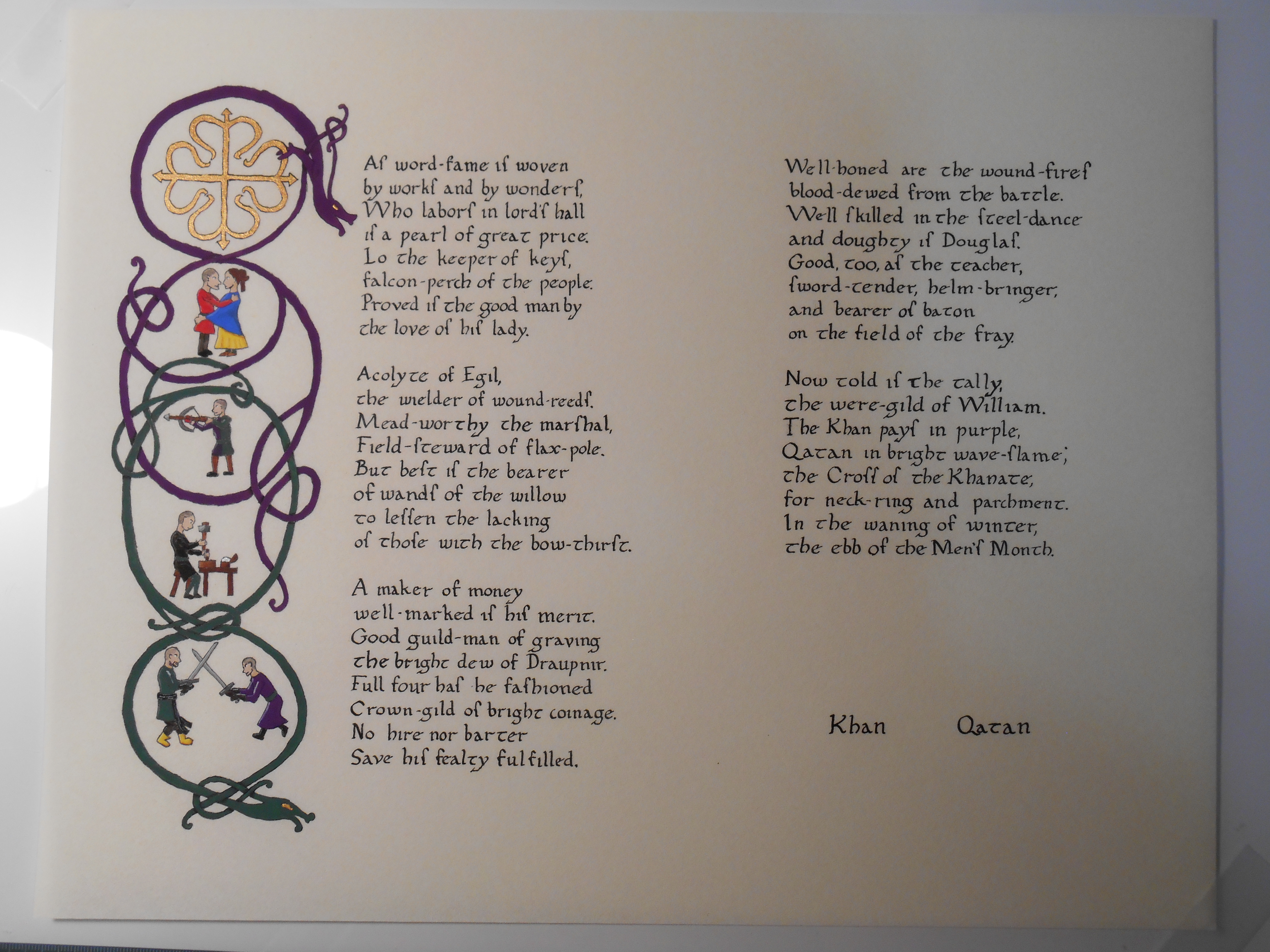

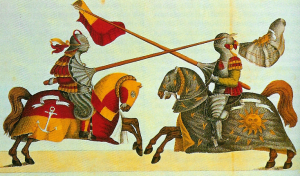

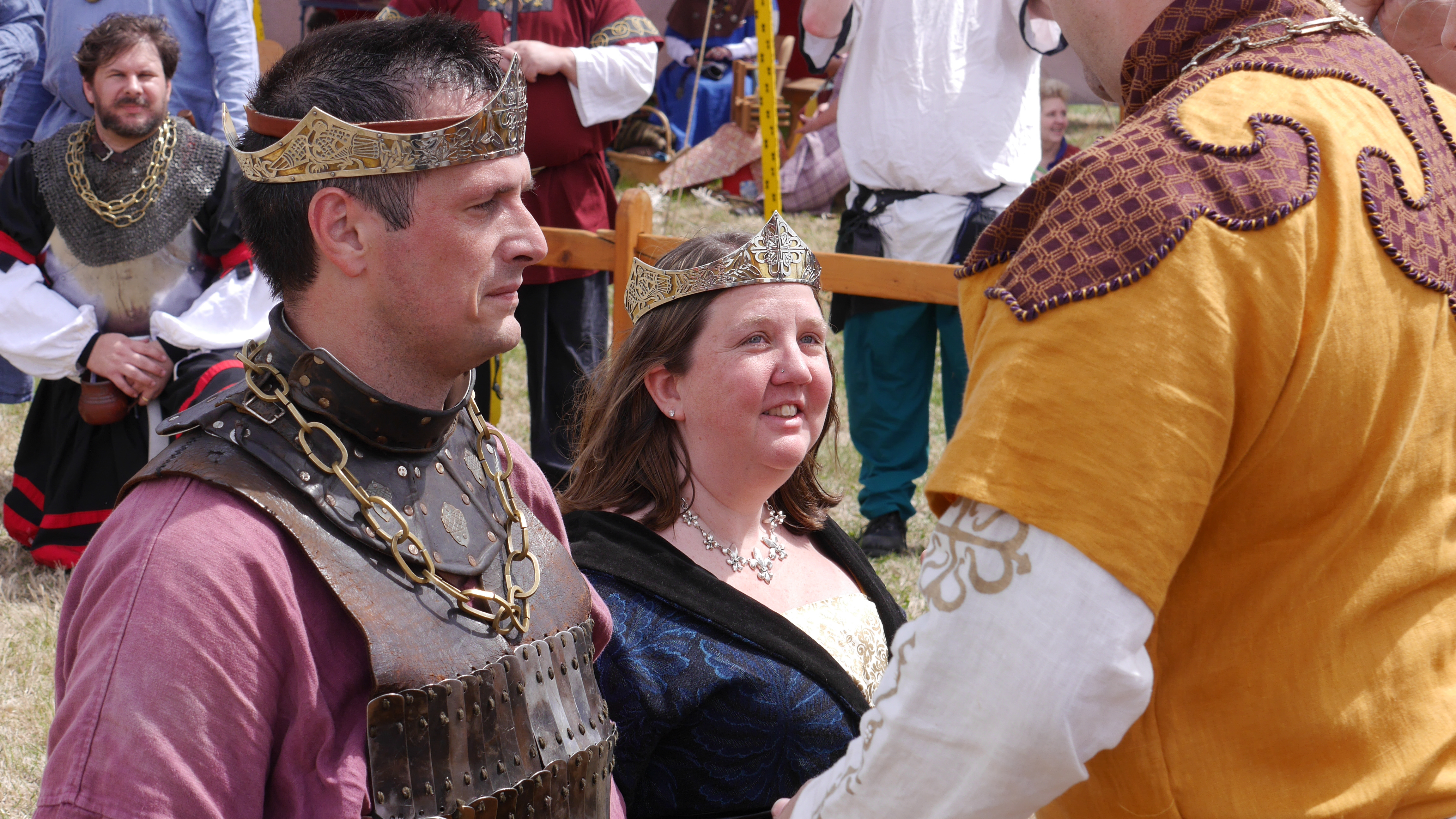
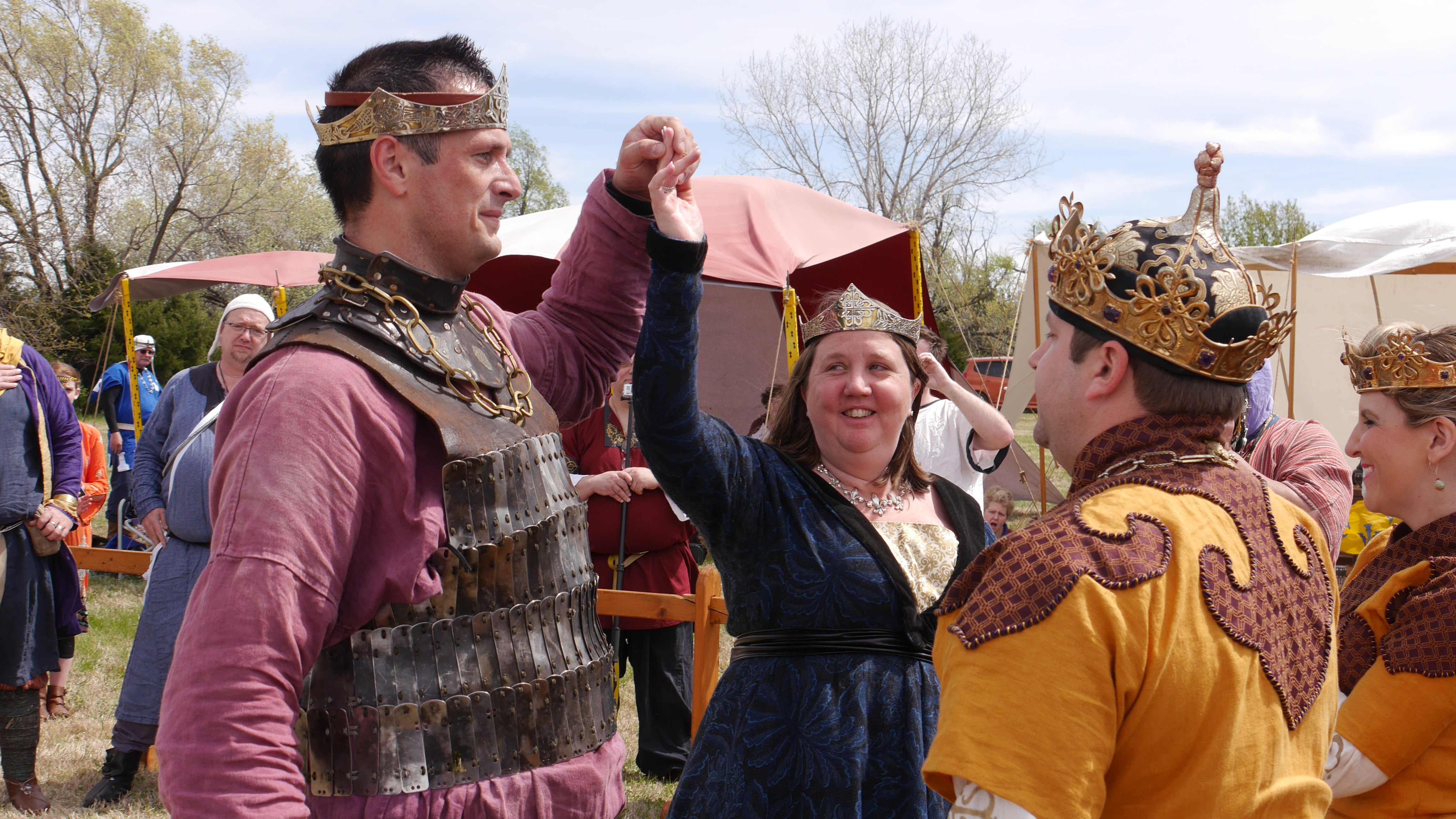
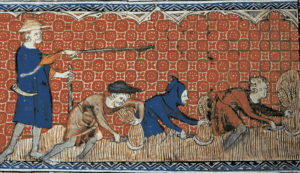
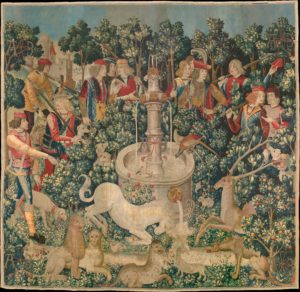
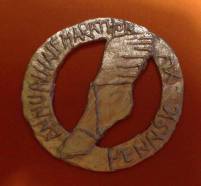

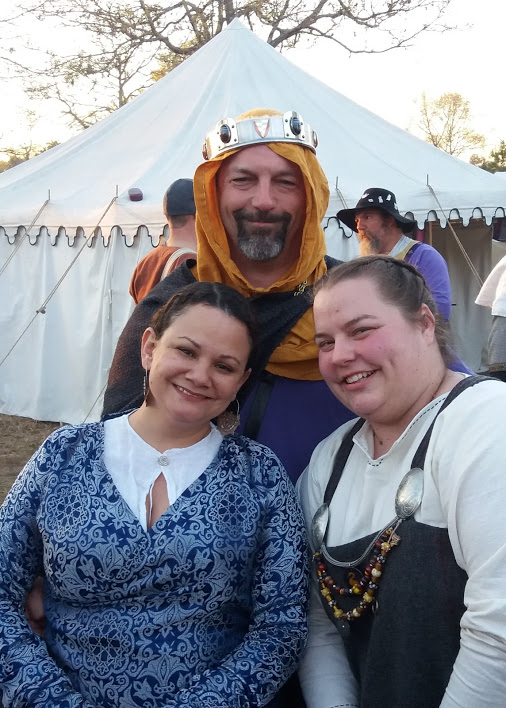
You must be logged in to post a comment.